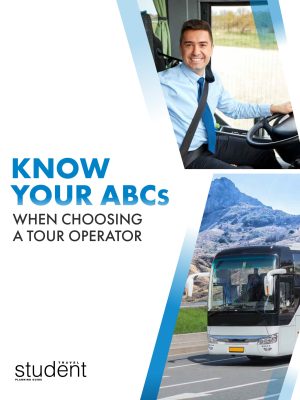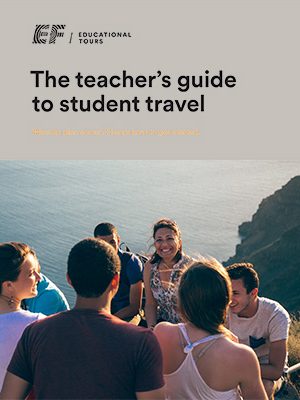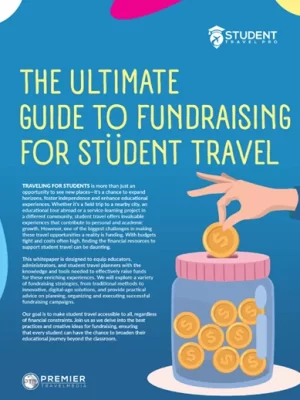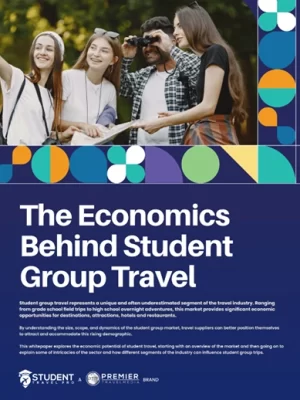Discover techniques for encouraging involvement during student travel while promoting responsibility and creating an enriching journey
Student travel presents a fantastic opportunity for students to learn, grow and bond with their peers. Whether it’s a field trip, a performance opportunity or a multi-day excursion, traveling with a group of students can create unforgettable memories and teach valuable life lessons. While exploring classroom subjects in the real world may be the initial goal of any student travel experience, the life experience and independence that comes with it are a bonus. Group travel offers a unique chance for students to take on leadership roles and develop a sense of responsibility while experiencing something new and exciting.
We’ve compiled five strategies and activities that are perfect for empowering student leaders and fostering responsibility during group travel. By encouraging active participation and providing students with a sense of authority, you’ll see that they are more likely to be engaged in the activities on the agenda, making it a win for everyone involved.
1. Set Expectations Before Embarking on Student Travel Adventures
![]()
Before the trip, it’s crucial to establish clear expectations for behavior, responsibility and safety with your students. Provide them with background on where they will be going, how they will get there and what will take place during the day(s) of your visit. Traveling as a group means interacting with the public in ways not traditional of a normal school day, so be sure to outline what this will look like. This can also be an opportunity to show photos or videos of the destination and even provide a little history if it’s relevant.
- Taking public transportation? Discuss how the system works and common courtesy. Taking a motorcoach? Outline safety protocols and expected behavior while on the bus.
- What locations will students be visiting during the day? Give them a sense of each destination and the overall vibe they can expect. Whether it’s a museum, a theme park or something in between, letting students know the protocol up front is the way to go.
Setting expectations while outlining the agenda prior to traveling will help students go in feeling prepared. And for those who might be anxious about venturing outside the classroom, knowing what to expect can be a big weight off their shoulders. With this preparedness comes a sense of inclusion, as students will feel they’re a part of the travel experience rather than just being along for the ride.
2. Give Students a Role when Traveling
Empower students by assigning them specific leadership roles, such as team captain, group spokesperson or student monitor. This gives them a sense of ownership and accountability, in turn making them more engaged in the activities at hand. Be sure to outline the specific roles and tasks assigned to each student leader and provide the tools they need to succeed. Looking for some examples of student-focused roles?

- Documentarian: Tasked with documenting the trip through photos, videos, or journal entries, capturing important moments and observations.
- Safety Officer: Ensures that all safety guidelines are followed, keeps an eye out for potential hazards and assists in emergency situations.
- Environmental Steward: Encourages responsible behavior towards the environment, such as picking up litter, respecting wildlife and minimizing ecological impact.
- Team Leader: Acts as a point of contact between the group and the teacher or chaperones, relaying information and addressing any concerns, and ensures everyone feels included and valued.
By assigning these roles, you can empower students to take ownership of their experience, develop leadership skills and contribute positively to the success of the field trip. You may find it beneficial to break up your group into smaller teams, too. In either case, assigning roles to students keeps them focused and integrates a leadership piece to the day’s activities.
3. Promote Student Collaboration & Decision-Making
Don’t let student travel be a one-way street. While there may be plenty of time for teachers or on-site leaders to present to student groups directly, it’s important that students are involved throughout the process and given ample time to engage with questions, activities and problem-solving scenarios. This not only helps them learn to communicate effectively but also promotes a sense of unity within the group.
- Provide students with activities that incorporate planning, observation and decision-making, and break them into small groups if needed. You may want to use tools such as worksheets or apps to provide structure, or perhaps students bring along their notebooks to jot down observations and questions.
Giving students a choice when it comes to various parts of the travel experience also cultivates a sense of involvement. Maybe it’s voting on activities or helping to manage a budget. Consider actions that allow for decision-making skills, as these help to give students a sense of responsibility over the travel plans.
4. Gamify the Student Travel Experience
Make any activity into a game and you’re sure to pique students’ interest. Incorporate elements of competition, collaboration and exploration into the day’s activities as a way to encourage engagement while getting everyone in on the fun. This also presents an opportunity to assign roles and leadership positions.
 Create scavenger hunts or treasure hunts related to the destination or learning objectives. Students can work in teams to solve clues, complete challenges, or find specific landmarks or objects within the field trip location. Select one student per group to be the spokesperson for an added responsibility.
Create scavenger hunts or treasure hunts related to the destination or learning objectives. Students can work in teams to solve clues, complete challenges, or find specific landmarks or objects within the field trip location. Select one student per group to be the spokesperson for an added responsibility.- Design role-playing activities where students assume the roles of historical figures or characters relevant to the trip, engaging them in interactive storytelling and problem-solving. Introducing point systems, rewards or badges for accomplishing tasks or demonstrating knowledge can further incentivize student engagement and participation.
- Integrating technology such as educational apps or augmented reality experiences can enhance the gamification aspect and provide opportunities for immersive learning.
By gamifying the student travel experience, teachers can foster excitement, curiosity and active learning among their students while still achieving all of their educational objectives.
5. Celebrate Student Achievements
It’s important to acknowledge and celebrate the achievements of students during and after the trip. Just getting out of the classroom and engaging in a new experience can be a lesson in stepping out of one’s comfort zone, and that’s something to be proud of. Recognize the hard work, dedication and contributions of your students and how they led to the trip’s success.

- Consider awards for students such as “Leadership Excellence Awards”, “Collaboration Champion”, “Team Spirit Award”, “Responsible Traveler”, “Curiosity Award” or any number of others. These can be given to individual students or to groups.
- For a lesson in democracy, have students vote for a Peer Recognition Award. This gives students a chance to recognize one another and reflect on contributions from the trip.
Take time in the moment and after the trip to reinforce positive actions of your students. A group debrief is also a great way to bring things full circle and allow students a chance to provide feedback on their travel experience, furthering their sense of inclusion.
Life Skills through Student Travel
Group travel can be a transformative journey for students, providing them with opportunities to develop leadership skills, responsibility and independence. Venturing outside the classroom is the perfect opportunity to instill these values in your students. By setting clear expectations, assigning leadership roles and offering guidance and support, you can empower student leaders and create a positive and enriching experience for everyone involved.
By Courtney Lind
Images courtesy of Freepik.com










